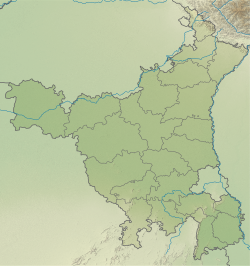| Kabuli Bagh Mosque | |
|---|---|
 The mosque in 2018 | |
| Religion | |
| Affiliation | Islam |
| Ecclesiastical or organizational status | Mosque |
| Status | Active |
| Location | |
| Location | Bajaj Nagar, Panipat, Panipat district, Haryana |
| Country | India |
Location of the mosque in Haryana | |
| Geographic coordinates | 29°23′45″N76°59′21″E / 29.395804°N 76.989137°E |
| Architecture | |
| Type | Mosque architecture |
| Style | |
| Founder | Babur |
| Completed | 1527 |
| Specifications | |
| Direction of façade | West |
| Dome(s) | 1 |
| Materials | Bricks; red sandstone; marble |
| Official name | Kabuli Bagh Mosque with enclosure wall |
| Reference no. | N-HR-71 |
The Kabuli Bagh Mosque is a mosque in Panipat, Haryana, India which was built in 1527 by the emperor Babur to mark his victory over Sultan Ibrahim Lodhi at the first Battle of Panipat in 1526. The mosque is named after Kabuli Begum, Babur's wife. [1] [2] The mosque and surrounding enclosure wall are a Monument of National Importance. [3]

